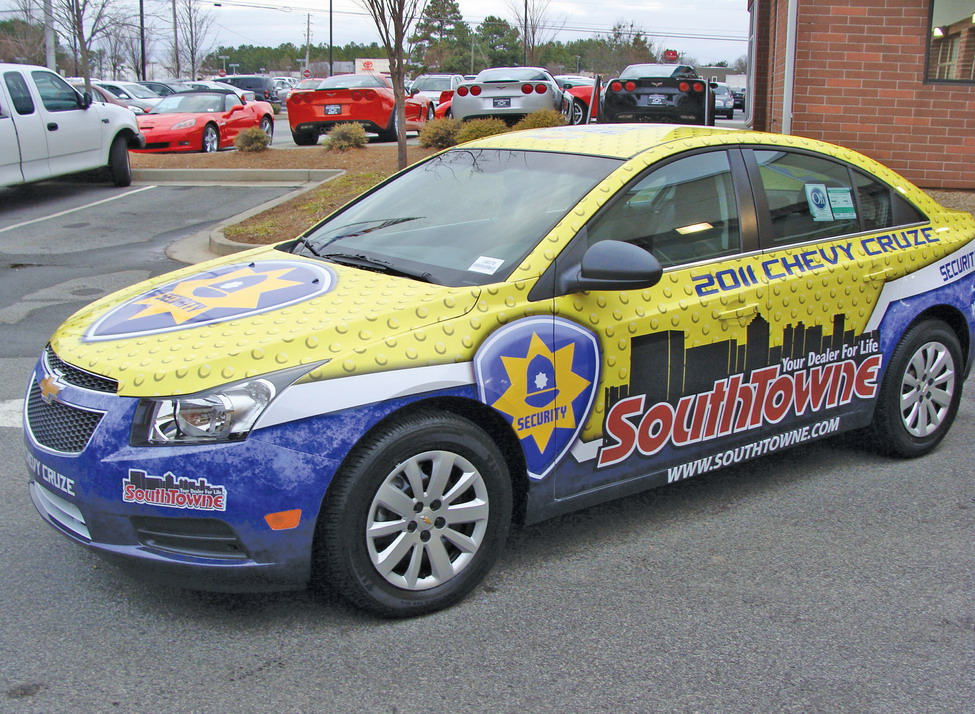Jim Miller, owner of Miller Decals LLC (Woodstock, GA), first began applying vinyl more than 30 years ago, and has been installing vehicle wraps for approximately two decades. He specializes in installation and affiliates with approximately 80 digital-service providers. The shop produces approximately 80 wraps a month, which are evenly divided between box trucks/trailers and vehicles. To attract more recognition, he’s entered several wrapping competitions – he won at the FESPA Wrap Cup Master competition in February – and has become certified through 3M, Fellers and Lowen.
“With the competition on the market, and the development of thinner, air-release films, the quality of media today is the best I’ve ever seen,” he said. “They make the job easier, but it still requires a skilled installer to make a job last for years and look as smooth as paint.”
Miller asks that customers deliver vehicles washed with soap and water – but no wax: “I’d rather they bring a car in filthy for me to wash than have to clear a wax job. Scrubbing wax off a surface adds hours to a wrap job.”
He recommends air-release media to his customers, and estimates using it on 90% of his wraps. When an air-release-media, solvent-ink wrap has been properly outgassed after printing, Miller said two installers can install a wrap in roughly three hours. On traditional media, or when a print hasn’t been properly outgassed, he projects a 10-hour job.
“Sometimes, it’s a red flag if a customer buys media sight unseen off the Internet,” he said. “Once, a customer showed up with this media with several black, 3M logos stamped haphazardly on the back of the liner. It was very obviously not 3M material. I told the customer I wouldn’t offer a warranty, and I’m sure the wrap didn’t last long.”
Miller Decals outfitted a fleet of Chevrolets for Southtowne, an Atlanta dealership. The job entailed two GMC Sierra pickup trucks and Chevrolet HHR’s apiece, and one Chevy Cruze and Pontiac Montana. WrapWizard.com (Newnan, GA) had printed the wraps with Avery MPI Supercast RS on a Mutoh Valuejet 1614, using eco-solvent inks.
Advertisement
Although the HHR is commonly viewed as one of the most difficult vehicles to wrap, Miller has become relatively proficient with them. He said, “It’s mostly a matter of getting the hang of the bumpers, which have a pretty sharp curve and a couple of bumpouts. Experience is the best teacher; you have to be careful and patient, and not overheat or overstretch the vinyl. On this car, we removed the mirrors and taillights to make the job easier.”
Conversely, he said the Cruze was ideal because the bumpers and sides join seamlessly, and no part removal was required.
To install a wrap, Miller said torches are typically the heatsource of choice. However, with matte-finish material, they use heat guns, because extra control is required to prevent a glossy sheen. He prefers Geekwraps’ squeegees, which offer a soft, leathery surface on one side and a hard, plastic edge on the other. To shepherd film into tight areas, he uses MACtac or Oshee felt squeegees or a custom, irregularly shaped, plastic squeegee.
To perfect installation techniques, Miller said it’s simply practice: “Take leftover material home and wrap your car again and again. Start with an established installer and pay attention. Read vinyl-manufacturer bulletins, and Rob Ivers’ The Graphic Installers’ Handbook. It’s full of information about every aspect of vinyl application.”



 Photo Gallery2 weeks ago
Photo Gallery2 weeks ago
 Paula Fargo2 weeks ago
Paula Fargo2 weeks ago
 Real Deal1 week ago
Real Deal1 week ago
 Photo Gallery2 weeks ago
Photo Gallery2 weeks ago
 Projects1 week ago
Projects1 week ago
 Business Management1 week ago
Business Management1 week ago
 News1 day ago
News1 day ago
 News1 week ago
News1 week ago







